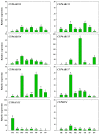Identification and Characterization of CYP6 Family Genes from the Oriental Fruit Moth (Grapholita molesta) and Their Responses to Insecticides
- PMID: 35323597
- PMCID: PMC8953268
- DOI: 10.3390/insects13030300
Identification and Characterization of CYP6 Family Genes from the Oriental Fruit Moth (Grapholita molesta) and Their Responses to Insecticides
Abstract
Cytochrome P450 (CYP) monooxygenases comprise a superfamily of proteins that detoxify xenobiotics and plant secondary metabolites in insects. The CYP6 family is unique to the class Insecta, and its members participate in the metabolism of exogenous substances. In this study, we sequenced and characterized the full-length cDNAs of eight CYP6 family genes from Grapholita molesta (Busck), a global pest of pome fruits. P450 genes with the exception of CYP6AN35, which was most highly expressed in adults, consistently showed high expression in third- or fourth-instar larvae. The analysis of different tissues of adults showed that most of these genes were predominantly expressed in the midgut, Malpighian tubules, and/or fat body. The expression of these eight CYP6 genes was differentially affected by three representative insecticides: malathion (organophosphate), deltamethrin (pyrethroid), and chlorantraniliprole (carbamate). All eight CYP6 genes responded to malathion treatment. Only three CYP6 genes were highly expressed in deltamethrin-treated individuals. Chlorantraniliprole treatment exerted weak effects on gene expression. Interestingly, CYP6AN35 was a highly expression level in the adult head and its expression was induced by all three insecticides. CYP6AN35 may be a key gene in the metabolism of insecticides. This study provides a fundamental understanding of the functions of the CYP6 gene family in insecticide metabolism in G. molesta.
Keywords: Grapholita molesta; chlorantraniliprole; cytochrome P450 monooxygenases; deltamethrin; expression; malathion.
Conflict of interest statement
The authors declare no conflict of interest.
Figures







References
-
- Liu Y.Q., Li G.W. Zoology of China, Insecta, Volume 27, Lepidoptera, Torridae. Science Press; Beijing, China: 2002. [(accessed on 25 January 2022)]. p. 601. Available online: http://www.zoology.csdb.cn/taxon/%7B2AA1F11E-9939-4034-B926-29FBE1D192D9%7D.
Grants and funding
- 201803D221004-7/the Key R & D Program of Shanxi Province
- 201903D211001-1/the Key R & D Program of Shanxi Province
- 20200018/the Fund Program for the Scientific Activities of Selected Returned Overseas Professionals in Shanxi Province
- 2020-066/Research Project Supported by Shanxi Scholarship Council of China
- CARS-28-19/Supported by China Agriculture Research System of MOF and MARA
LinkOut - more resources
Full Text Sources

